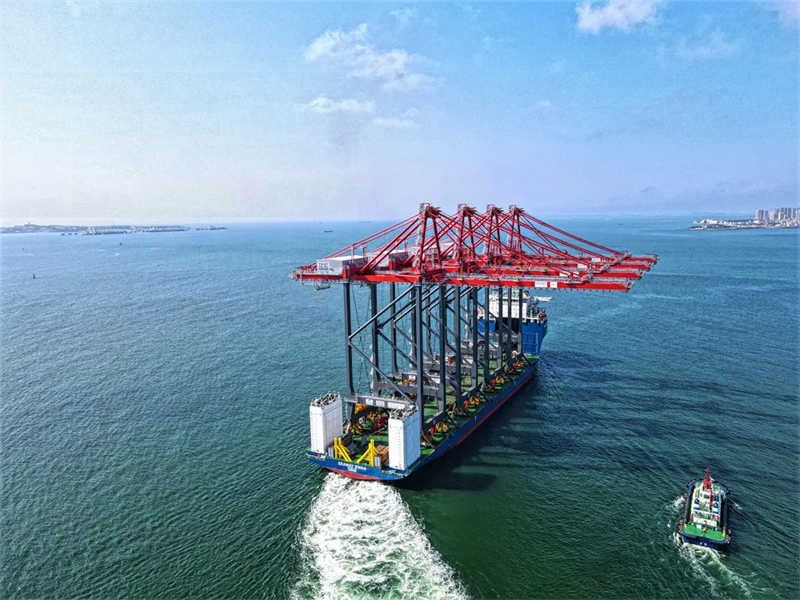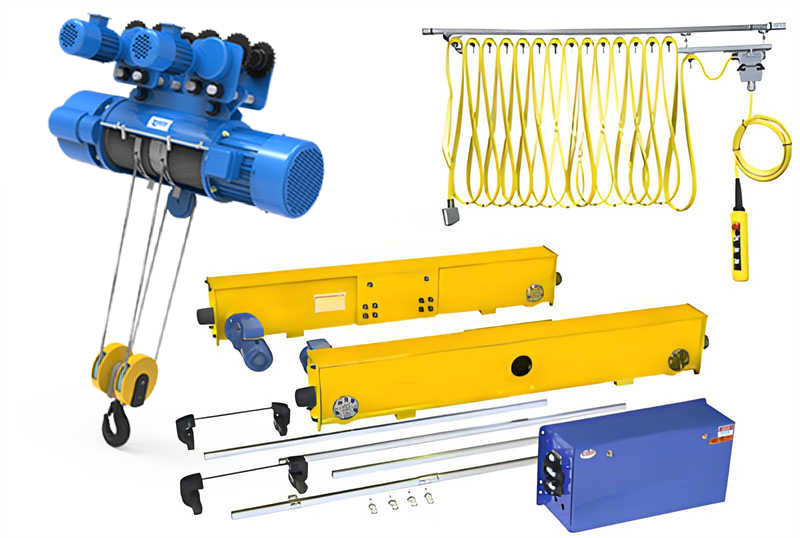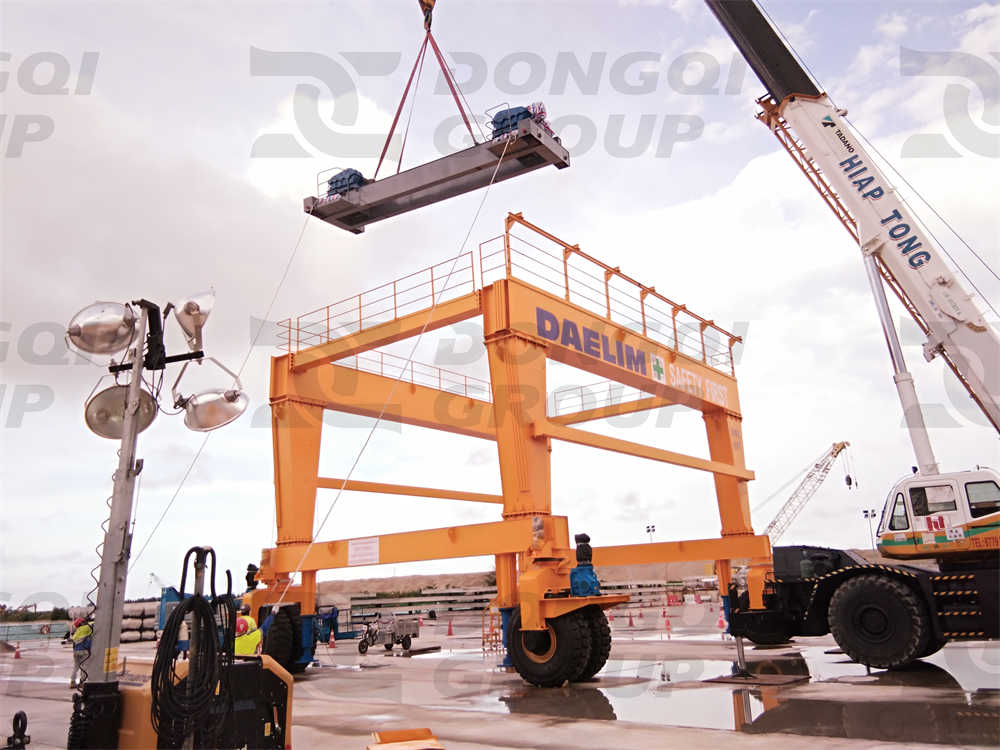9-Jan-2025
Rubber-tyred gantry crane (RTG) applications in civil engineering/infrastructure construction
Basic definition and functions of rubber tire gantry crane (RTG)
The rubber tire gantry crane (RTG) is a heavy-duty mechanical equipment that combines efficiency, flexibility and powerful lifting capabilities. It adopts a tire running device and can move freely on various complex terrains, and completes the hoisting operations of various heavy objects through its powerful lifting mechanism. RTG is mainly used for loading, unloading, handling and stacking of large goods. It is an indispensable and important equipment in the fields of logistics, ports and civil engineering.
In civil engineering and infrastructure construction, the construction of large projects such as bridges, viaducts and tunnels often requires the lifting of large quantities of heavy components and equipment. Traditional hoisting methods often have problems such as low efficiency, complex operations, and difficulty in ensuring safety. RTG has become an important tool to solve these problems with its efficient lifting capacity, flexible mobility and precise lifting positioning capabilities. The application of RTG not only significantly improves construction efficiency and reduces construction costs, but also greatly improves construction safety and project quality. Therefore, the application of RTG in civil engineering and infrastructure operations has important background and significance.
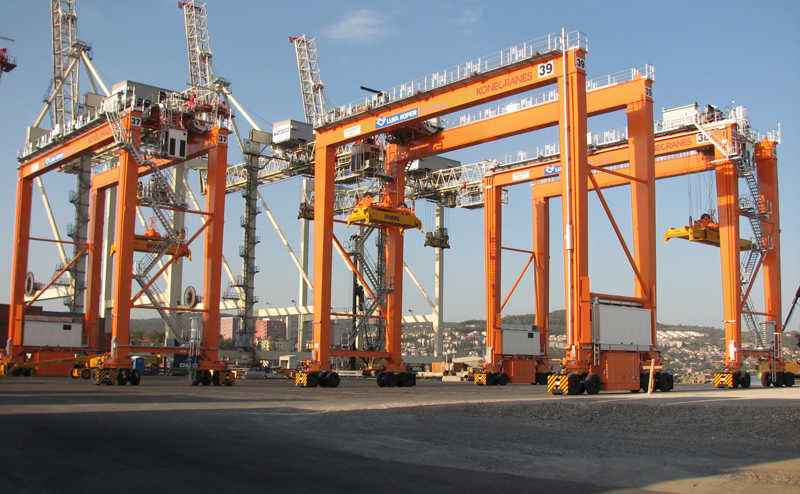
Overview of technical features of rubber tire gantry crane (RTG)
Structural composition and working principle of RTG
RTG is mainly composed of gantry structure, tire travel device, lifting mechanism, electrical control system and cab. The gantry structure, as the main frame of RTG, bears the weight and lifting tasks of the whole machine. The tire travel device gives RTG the ability to move flexibly, enabling it to move freely on various complex terrains. The lifting mechanism is the core component of RTG, and it completes the lifting operations of various heavy objects through its precise lifting and positioning capabilities. The electrical control system is responsible for the stable operation and precise operation of RTG, ensuring the safety and reliability of the entire lifting process. The cab provides operators with a comfortable and safe working environment, enabling them to efficiently complete various operating tasks.
Mobility, flexibility, efficiency and heavy load capacity of RTG
The tire travel device of RTG gives it excellent mobility and flexibility, enabling it to move freely on various complex terrains and adapt to various construction environments. Its efficient lifting capacity and precise lifting and positioning capabilities enable RTG to complete the lifting operations of a large number of heavy objects in a short time, significantly improving construction efficiency. At the same time, RTG also has a strong heavy-load capacity and can hoist various heavy components and equipment to meet various complex hoisting requirements in civil engineering and infrastructure construction.
RTG’s applicability and advantages in civil engineering
RTG is widely applicable in the field of civil engineering, especially in the construction of large projects such as bridges, viaducts and tunnels, the application of RTG is indispensable. Its advantages such as mobility, flexibility, high efficiency and heavy-load capacity enable RTG to easily cope with various complex construction environments and hoisting requirements. At the same time, RTG also has high economy and safety, which can significantly reduce construction costs and improve construction safety. Therefore, the application of RTG in the field of civil engineering has significant advantages and broad prospects.

Application of RTG in bridge construction
The role of RTG in the hoisting of bridge prefabricated parts
In bridge construction, prefabricated components such as prefabricated beams and bridge decks are important parts of the main structure of the bridge. RTG plays a vital role in the hoisting of bridge prefabricated parts. Its role is mainly reflected in the following aspects:
Efficient handling and installation of prefabricated parts:
- With its powerful lifting capacity and precise hoisting positioning capabilities, RTG is able to efficiently handle and install bridge prefabricated components. This not only significantly improves construction efficiency, but also ensures the stability and safety of prefabricated parts during installation. Through the precise operation of RTG, prefabricated parts can be accurately placed at the designed location, laying a solid foundation for subsequent bridge construction.
Ensure the safety and accuracy of bridge construction:
- Bridge construction has extremely high requirements for safety and precision. RTG is equipped with advanced electrical control systems and safety devices to ensure stability and safety during the hoisting process. At the same time, RTG’s precise hoisting and positioning capabilities also ensure the accuracy of prefabricated parts during installation, thus ensuring the overall stability and service life of the bridge.
RTG’s flexibility and adaptability on bridge construction sites
Bridge construction sites often have complex terrain and narrow spaces, which place high demands on the flexibility and adaptability of construction equipment. The flexibility and adaptability of RTG at the bridge construction site are mainly reflected in the following aspects:
Operating capabilities on complex terrain and narrow spaces:
- RTG adopts tire running device, which can move freely on various complex terrains and adapt to various construction environments. At the bridge construction site, RTG can easily pass through narrow spaces to reach the storage location or installation location of prefabricated parts to complete hoisting operations. This flexibility not only improves construction efficiency, but also reduces disruption and damage to the construction site.
Shorten the construction period and reduce costs:
- RTG’s efficient lifting capacity and precise hoisting and positioning capabilities make the handling and installation process of bridge prefabricated parts faster and more accurate. This not only shortens the construction period and reduces construction costs, but also improves construction quality and safety. At the same time, the long-term use and maintenance costs of RTG are relatively low, further reducing the overall cost of bridge construction.

Innovative application of RTG in viaduct construction
RTG strategy in hoisting viaduct structural parts
Efficient lifting and precise positioning
In the hoisting of viaduct structural parts, RTG achieves efficient lifting and precise positioning with its powerful lifting capacity and precise control system. Traditional hoisting methods often require repeated adjustments between multiple hoisting points, which is inefficient and difficult to ensure accuracy. RTG, with its precise control system and powerful lifting mechanism, can complete the precise hoisting of structural parts at one time, greatly improving construction efficiency. At the same time, RTG’s tire walking device enables it to move flexibly at the viaduct construction site and adapt to various complex terrains, further improving construction efficiency.
Optimize construction process and improve overall efficiency
The application of RTG in the hoisting of viaduct structural parts is also reflected in the optimization of construction processes. By accurately calculating the weight, size and hoisting position of the structural parts, RTG can complete the hoisting of multiple structural parts at one time, reducing the number of hoisting times and hoisting time. At the same time, RTG’s control system can also monitor the hoisting process in real time to ensure the safety and stability of the hoisting process. This optimized construction process not only improves construction efficiency, but also reduces construction costs.
Safety and reliability of RTG in viaduct construction
Real-time monitoring and fault warning system
Safety is of vital importance in viaduct construction. RTG is equipped with an advanced real-time monitoring and fault warning system, which can monitor the working status of the lifting mechanism, electrical control system and tire walking device in real time. Once an abnormal situation is found, the system will immediately issue a warning signal to remind the operator to take timely measures. This real-time monitoring and fault warning system greatly improves the safety and reliability of RTG in viaduct construction.
Reduce construction accidents and ensure personnel safety
The application of RTG not only improves construction efficiency, but also significantly reduces the incidence of construction accidents. Traditional lifting methods often require operators to perform dangerous operations at high altitudes, which poses great safety hazards. RTG can achieve remote control operation through its precise control system and powerful lifting capacity, avoiding the risk of operators working at high altitudes. At the same time, the tire walking device of RTG also enables it to walk stably on complex terrain, reducing construction accidents caused by uneven terrain. This safe and reliable construction method provides a strong guarantee for viaduct construction.
Auxiliary role of RTG in tunnel engineering
Role of RTG in material handling for tunnel construction
Rapid transportation of heavy equipment and materials
During tunnel construction, various heavy equipment and materials, such as tunnel boring machines, support equipment, stone, cement and steel bars, often need to be transported. With its powerful lifting capacity and flexible tire walking device, RTG can quickly and accurately complete the transportation tasks of these heavy equipment and materials. RTG can not only carry out efficient loading and unloading operations outside the tunnel entrance, but also carry out short-distance transportation inside the tunnel, which greatly improves construction efficiency.
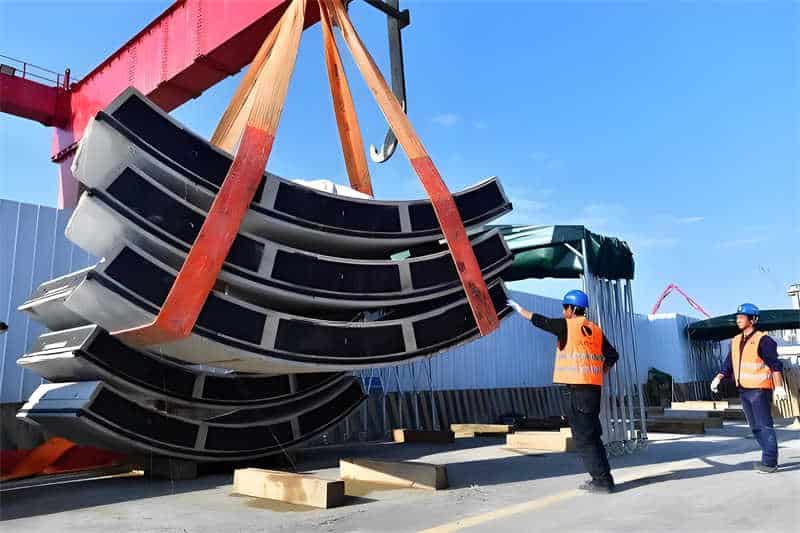
Optimize space utilization in tunnel construction
Tunnel construction space is usually limited and there are many obstacles. The compact design and flexible mobility of RTG enable it to operate efficiently in a narrow space and maximize the use of every inch of space in the tunnel. By precisely controlling the movement path and hoisting operations of RTG, construction units can organize the construction site more effectively, reduce space waste, and ensure the smooth progress of the construction process.
Potential application scenarios of RTG in tunnel construction
Erection and removal of temporary structures
In tunnel construction, temporary structures are often required to support tunnel walls, protect construction personnel or serve as construction platforms. RTG can be used to hoist and install the steel beams, brackets and other materials required for these temporary structures. Similarly, after the tunnel construction is completed, RTG can also efficiently dismantle these temporary structures to ensure the cleanliness and safety of the construction site.
Maintenance and overhaul of equipment inside the tunnel
Various equipment inside the tunnel, such as ventilation equipment, lighting equipment, drainage system, etc., need to be regularly maintained and overhauled. The lifting capacity and flexibility of RTG make it an ideal tool for completing these tasks. With RTG, construction personnel can easily hoist maintenance tools and spare parts to high or hard-to-reach areas inside the tunnel to ensure the normal operation of the equipment and the safe progress of tunnel construction.
In addition, RTG can also be used to hoist and install various monitoring equipment inside the tunnel, such as displacement sensors, stress sensors, etc., to monitor the stability and safety of the tunnel in real time.
Comprehensive benefit analysis of RTG in civil engineering
The application of rubber tire gantry cranes (RTG) in civil engineering not only brings significant economic benefits, but also generates positive social and environmental benefits. The following is an analysis of the comprehensive benefits of RTG in civil engineering:
1. Economic benefits
Reduce costs:
- Equipment purchase cost: Although the initial purchase cost of RTG is relatively high, its long-term operation and maintenance costs are relatively low, and its efficient working capabilities significantly reduce unit operating costs.
- Labor costs: RTG has a high degree of automation and intelligence, which reduces labor requirements and labor costs.
- Material loss: Precise lifting and positioning capabilities reduce material loss during the lifting process, further reducing costs.
Improve construction efficiency:
- Fast lifting: RTG’s lifting capacity and moving speed are superior to traditional lifting equipment, and it can complete the lifting of a large number of heavy objects in a short time, significantly improving construction efficiency.
- Continuous operation: RTG’s tire traveling device enables it to move quickly between different operating points, achieving continuous operation and reducing waiting time.
2. Social benefits
Shorten the construction period:
- RTG’s efficient operating capabilities greatly shorten the construction cycle, thereby speeding up project delivery and bringing faster returns to owners and investors.
- Shortening the construction period also means reducing the impact of construction on surrounding residents and traffic, improving social satisfaction.
Improve construction safety:
- RTG is equipped with advanced electrical control systems and safety devices, which can provide real-time safety monitoring and early warning during the construction process, effectively reducing the risk of accidents.
- Precise lifting and positioning capabilities reduce the uncertainty caused by manual operations and further improve construction safety.
Promote employment and skills training:
- The application of RTG promotes the development of related industries and provides employment opportunities for more people.
- At the same time, the operation and maintenance of RTG require professional skills, which promotes relevant skills training and talent cultivation.
3. Environmental benefits
Low emissions:
- RTGs are usually driven by electricity, which has lower emissions than fuel-driven equipment and is conducive to environmental protection.
- With the development of electric vehicles and clean energy technology, the environmental performance of RTG will be further improved.
Green construction:
- RTG’s precise lifting and positioning capabilities reduce material waste and pollution during the lifting process, promoting green construction.
- RTG’s efficient operating capabilities shorten the construction period and reduce energy consumption and emissions during the construction process.

Future Prospects of RTG in Civil Engineering/Infrastructure Operations
1. Technological Innovation: Development Trend of Intelligence and Automation
With the continuous development of science and technology, rubber tire gantry cranes (RTGs) are also undergoing intelligent transformation. Future RTGs will pay more attention to technological innovation, especially in intelligence and automation.
- Automated operation: The development of automation technology will drive RTGs towards unmanned and autonomous operation. In the future, RTGs may complete tasks such as lifting, transportation and stacking autonomously through preset programs and instructions, thereby greatly reducing manual intervention and improving operation efficiency.
- Intelligent control system: By introducing advanced sensor technology, artificial intelligence algorithms and remote communication technology, RTGs will be able to achieve more precise lifting operations and more efficient operation management. Intelligent control systems can monitor and adjust the working status of RTGs in real time to ensure their stability and safety in various complex environments.
- Environmental monitoring and adaptation: RTGs will be equipped with more advanced environmental monitoring systems that can sense changes in the construction environment in real time, such as wind, temperature, humidity, etc., and automatically adjust operating parameters to ensure the safety and stability of lifting operations.
2. Application expansion: potential applications in more fields
The successful application of RTG in civil engineering and infrastructure construction has provided the possibility for its expansion in other fields.
- New energy construction: With the vigorous development of the new energy industry, RTG will have a broader application space in the construction of new energy projects such as wind power and photovoltaics. For example, in the construction of wind farms, RTG can be used to hoist large components such as wind turbine towers and blades.
- Urban rail transit: In the construction of urban rail transit, RTG can be used for hoisting and assembly operations of large facilities such as subway stations and vehicle depots, as well as various hoisting tasks during track laying and commissioning.
- Special projects: In some special projects, such as the construction of large stadiums, convention and exhibition centers and other buildings, RTG can also play an important role. Its powerful lifting capacity and flexible mobility enable RTG to cope with various complex and special hoisting requirements.
3. Industry impact: Promote the modernization of the civil engineering industry
The wide application and continuous innovation of RTG will have a profound impact on the civil engineering industry and promote its development in the direction of modernization and intelligence.
- Improve construction efficiency: RTG’s efficient lifting capacity and precise hoisting and positioning capabilities will significantly improve the construction efficiency of civil engineering, shorten construction period and reduce construction costs.
- Improve project quality: Intelligent RTG can control hoisting operations more accurately, reduce human errors, and improve project quality and safety.
- Promote technological innovation: RTG’s technological innovation will drive the technological progress and innovative development of the entire civil engineering industry and promote the industry to a higher level.
- Promote talent training: With the widespread application of RTG in the field of civil engineering, the demand for relevant professional talents will continue to increase. This will promote the training and introduction of relevant talents and provide a strong talent guarantee for the development of the civil engineering industry.
In summary, the application prospects of rubber tire gantry cranes (RTGs) in civil engineering and infrastructure construction are broad, and in the future, they will achieve greater development in intelligence, automation, application expansion and industry influence. With the continuous advancement of technology and the deepening of application, RTG will play a more important role in future civil engineering and contribute to the modernization process of the industry.
Buy RTG Cranes Now
At Dongqi Crane, we focus on providing customers with efficient, flexible and powerful rubber tire gantry cranes (RTGs) to meet your diverse needs in civil engineering construction such as bridges, viaducts, tunnels, etc.
Our RTG products not only have excellent lifting capacity and precise lifting and positioning technology, but also excel in mobility and flexibility. Whether on complex construction terrain or in a small working space, Dongqi Crane’s RTG can easily cope with it, ensuring that your construction progress is not hindered in any way.
Contact us now to learn more about Dongqi Crane’s rubber tire gantry cranes!

